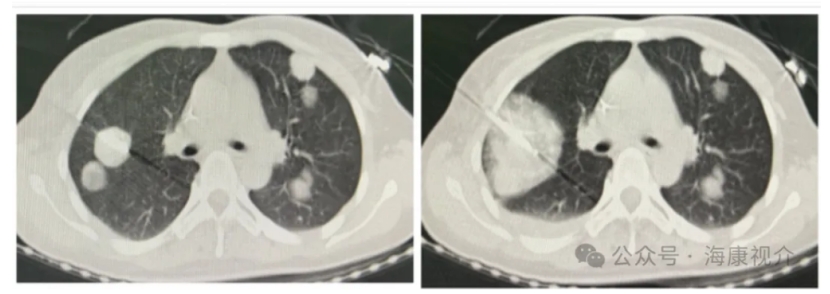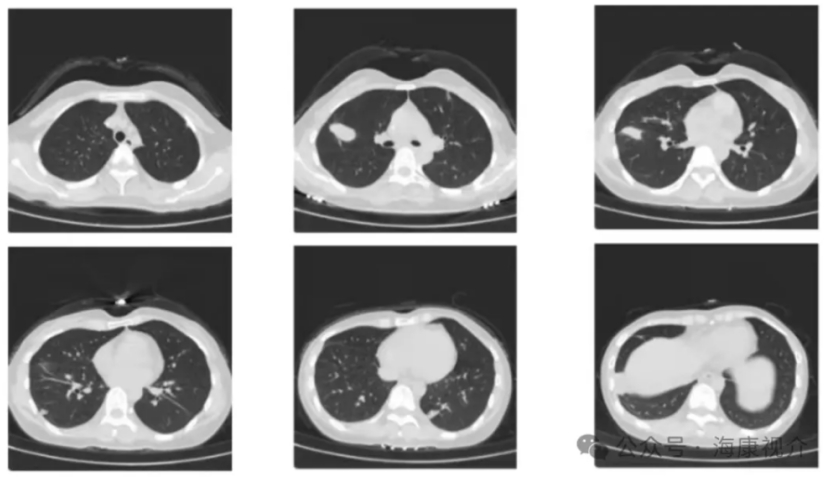Summary: The article shared a case of percutaneous puncture treatment for lung metastasis of liver cancer with Cryosurgical System. Professor Huang Jinhua, Sun Yat-sen University Cancer Center, commented on the case.
Basic information: Female, 36 years, admitted to hospital after more than 2 months of comprehensive treatments for the “lung metastasis of liver cancer”, with pain score of 0, free from diabetes, hypertension, coronary heart or surgical history. The patient visited Zhongshan City People’s Hospital on July 16, 2021 due to “upper abdominal pain”.
Contrast-enhanced MR of the upper abdomen: multiple intrahepatic masses were observed, with the largest mass located in S4, approximately 6.5 cm in size, and AFP>1,000 ng/ml, suspected of hepatocellular carcinoma.
History of previous treatments: After the diagnosis, the patient received transcatheter arterial chemoembolization (TACE) for five times on July 23, September 9, October 18, November 24 and December 28, 2021 respectively. During this period, she received treatments with Lenvatinib (8 mg QD) and Sintilimab (200 mg). On February 15, 2022, she received HAIC treatment once and the target drug was changed to Regorafenib (120 mg). During the follow-up period, the level of alpha fetoprotein increased gradually, so the drug was changed to Lenvatinib (8 mg QD) again in April 2022. On July 23, 2021, she received TACE and Lenvatinib (8 mg QD) treatments in a local hospital. On August 23, 2021, the upper abdomen MR + chest CT re-scan one month after the surgery showed a liver S4 tumor, 6.5 cm, suspected of changes after hepatocellular carcinoma interventional surgery, still with tumor activity. Multiple sub-lesions were observed on right lobe of liver. Multiple metastasis occurred in bilateral lungs, with the largest one of 6 mm. “AFP: 3,031 ng/ml.” The patient received TACE, Lenvatinib and Sintilimab treatments for four times from September 9 to December 28, 2021, and HAIC was performed once on February 15, 2022 combined with Regorafenib treatment.
Clinical diagnosis:
1. Bilateral lung hepatocellular carcinoma metastasis - BCLC Stage C and CNLC Stage IIIb
2. Compensated cirrhosis - Child Pugh 5 points - Grade A
3. Chronic viral hepatitis B
Regimen: Cryosurgical System® co-ablation treatment combined with Lenvatinib + Cadonilimab
No findings were observed in complete blood cell count, clinical chemistry, coagulation function and tumor indexes.
Complete blood cell count: WBC: 2.85×109/L, RBC: 4.09×1,012/L, PLT: 96×109/L.
Clinical chemistry: AST: 36 U/L, ALT: 17 U/L, ALB: 49.3 g/L, TBIL: 9.5 mmol/L.
Hemostasis and coagulation examination: PT: 10.4 s
Tumor-associated antigen: AFP: 955 IU/ml, CA199: 125 U/ml
Hepatitis B two and a half examination: HBsAg+, HBsAb-, HBeAg-, HBeAb+, HBcAb+

On May 19, 2022, upper abdomen MR showed no residual activity in liver lesions;
The metastasis tumors in bilateral lungs increased in number and size.

On September 2, 2022, CT scan in another hospital showed multiple metastases to bilateral lungs, the metastasis tumors in bilateral lungs increased in number and size.

From September 2022 to December 2022, a total of 6 courses of intravenous chemotherapy with FOLFOX6 protocol were performed.
On February 20, 2023, CT scan in another hospital showed multiple metastasis tumors in bilateral lungs, and the metastasis tumors in bilateral lungs increased in number and size.
Cryosurgical System co-ablation regimen: The patient was in a supine position, and 1 probe was arranged.
Intraoperative ablation parameters: freeze for 15 min × 2 cycles and rewarm for 5 min × 2 cycles

(Left: Arrangement of ablation needle in place; Right: After two cycles of ablation)

(Chest CT one month after the surgery: the size of ablation lesion was approximately 40 × 30 mm; It showed that the ablation lesions completely resolved, and other lesions in bilateral lungs obviously decreased in number and size.)

(Chest CT three months after surgery: the size of ablation lesion was approximately 40 × 25 mm; It showed that the ablation lesions completely resolved, and other lesions in bilateral lungs obviously decreased in number and size.)

(Left: before surgery; middle: 1 month after surgery; right: 3 months after surgery;
3D images showed the lesions in bilateral lungs generally decreased in number and size.)

(6 months after the surgery: Ablation lesion in the right lung showed no definite activity and the lesions in bilateral lung further decreased in number and size.)
The patient was diagnosed with bilateral lung metastases of liver cancer, and failed in multi-line systemic therapy;
Upon MDT discussion, the Cryosurgical System® co-ablation treatment was conducted, the 1-needle and 2-cycle regimen was selected during the surgery, which proved successful.
The patient recovered well after the surgery and was discharged 3 days after the surgery.
The patient received a combination regimen with Lenvatinib + Cadonilimab after the surgery.
Reexamination 1, 3 and 6 month(s) after the surgery showed inactivation of local lesions, with significant decrease in number and size of other lesions in bilateral lungs and significant decrease in tumor markers level, and most of the tumors resolved.
Efficacy evaluation: The patient showed good local control effect and the purpose of therapy was achieved; Cryosurgical System could reduce the tumor burden and the number of TrmgCD4+T cells relieve the tumor immunosuppression. Ablation could enhance vascular permeability, recruit more CD8+T cells, and increase tumor-infiltrating lymphocytes (TILA), thereby assist in delivering more “energy”.
Device use experience: During the treatment with Cryosurgical System, the temperature could rise and drop quickly, the ice ball forms quickly, and the ablation zone of single needle was large. Cryosurgical System had a much lower temperature, up to -196oC, leading to more significant tumor ischemia; the high temperature was much higher, resulting in cell rupture, coagulation and necrosis, thereby achieving hemostasis and preventing tumor dissemination.
Comments from experts:
Evaluation of the regimen: The patient was diagnosed with multiple metastases of liver cancer in bilateral lungs. After multiple cycles of systemic treatment, the efficacy was still poor. After MDT discussion, the patient was treated with Cryosurgical System combined with Lenvatinib + Cadonilimab. After the activation of the immunity with Cryosurgical System, the patient further received targeted immunotherapy. The follow-up 3 months after the surgery showed that the local control effect was good, which achieved the goal of treatment and effectively improved the quality of life. In this regimen, a large number of new antigens can be quickly released after the ablation, which represented a real tumor vaccine in vivo, but the immune response induced by the regimen was not enough to eliminate the tumor or block the recurrence of the tumor. Exogenous immunotherapy can be combined to produce the synergistic effects.
Evaluation of the Cryosurgical System: As the world’s first and original domestic high-end medical device, Cryosurgical System boasts the technical characteristics of large temperature difference, rapid cooling and heating, quickly formation of ice ball, and large ablation zone of single needle. At present, Cryosurgical System has been widely used in tumor centers of many Grade 3 A hospitals in China, and its application in the treatment of liver cancer, lung cancer, bone tumor, pancreatic cancer, thyroid cancer, breast cancer and other diseases has been recognized by clinical experts; Since the application of Cryosurgical System in our hospital, 800 cases of cryoablations in various types have been completed with an excellent clinical effect.
Surgeon: Professor Huang Zhimei
Advantages: cryoablation treatment; the annual number of operations is about 500 cases, and a total of 5,000 cases have been completed;
Surgical team: surgical team led by Professor Huang Jinhua from the Department of Minimally Invasive Interventional Therapy, Sun Yat-sen University Cancer Center;
The Department of Minimally Invasive Interventional Therapy of Sun Yat-sen University Cancer Center has 78 beds, with an average annual ablation surgery of 5,000 cases;
Attending physician, department secretary and doctor of Interventional Department of Yat-sen University Cancer Center.
Young member of Minimally Invasive Tumor Intervention Committee of World Association of Chinese Oncologist
Member of Intervention Professional Committee of China Women Medical Doctor Association
Member of Tumor Intervention Committee of Guangdong Association of Organ Medicine and Technology
Member of Multiple Primary and Unknown Primary Tumor Committee of Guangdong Provincial Anticancer Association
Secretary of Minimally Invasive Tumor Committee of Guangzhou Anti-cancer Association
Professor Huang Jinhua
Chief physician, professor and doctoral supervisor of Department of Minimally Invasive Interventional Therapy, Sun Yat-sen University Cancer Center
Vice chairman and secretary general of Guangdong Provincial Anticancer Association
Chairman of Ultrasound Treatment Committee of China Anti-cancer Association
Member of Intervention Group of Radiology Branch of Chinese Medical Association
Vice chairman of Minimally Invasive Liver Cancer Intervention Committee of Chinese Medical Doctor Association
 Hygea Medical Technology Co., Ltd.
Hygea Medical Technology Co., Ltd.